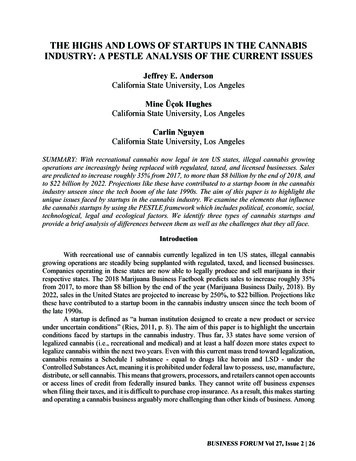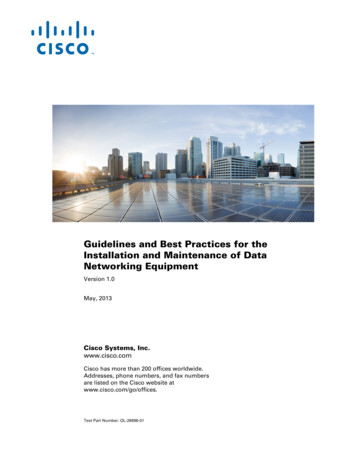
Transcription
THE HIGHS AND LOWS OF STARTUPS IN THE CANNABISINDUSTRY: A PESTLE ANALYSIS OF THE CURRENT ISSUESJeffrey E. AndersonCalifornia State University, Los AngelesMine Üçok HughesCalifornia State University, Los AngelesCarlin NguyenCalifornia State University, Los AngelesSUMMARY: With recreational cannabis now legal in ten US states, illegal cannabis growingoperations are increasingly being replaced with regulated, taxed, and licensed businesses. Salesare predicted to increase roughly 35% from 2017, to more than 8 billion by the end of 2018, andto 22 billion by 2022. Projections like these have contributed to a startup boom in the cannabisindustry unseen since the tech boom of the late 1990s. The aim of this paper is to highlight theunique issues faced by startups in the cannabis industry. We examine the elements that influencethe cannabis startups by using the PESTLE framework which includes political, economic, social,technological, legal and ecological factors. We identify three types of cannabis startups andprovide a brief analysis of differences between them as well as the challenges that they all face.IntroductionWith recreational use of cannabis currently legalized in ten US states, illegal cannabisgrowing operations are steadily being supplanted with regulated, taxed, and licensed businesses.Companies operating in these states are now able to legally produce and sell marijuana in theirrespective states. The 2018 Marijuana Business Factbook predicts sales to increase roughly 35%from 2017, to more than 8 billion by the end of the year (Marijuana Business Daily, 2018). By2022, sales in the United States are projected to increase by 250%, to 22 billion. Projections likethese have contributed to a startup boom in the cannabis industry unseen since the tech boom ofthe late 1990s.A startup is defined as “a human institution designed to create a new product or serviceunder uncertain conditions” (Ries, 2011, p. 8). The aim of this paper is to highlight the uncertainconditions faced by startups in the cannabis industry. Thus far, 33 states have some version oflegalized cannabis (i.e., recreational and medical) and at least a half dozen more states expect tolegalize cannabis within the next two years. Even with this current mass trend toward legalization,cannabis remains a Schedule I substance - equal to drugs like heroin and LSD - under theControlled Substances Act, meaning it is prohibited under federal law to possess, use, manufacture,distribute, or sell cannabis. This means that growers, processors, and retailers cannot open accountsor access lines of credit from federally insured banks. They cannot write off business expenseswhen filing their taxes, and it is difficult to purchase crop insurance. As a result, this makes startingand operating a cannabis business arguably more challenging than other kinds of business. AmongBUSINESS FORUM Vol 27, Issue 2 26
many unexplored areas in the business literature on this topic are the classification of cannabisstartups and the unique challenges they face.Inspired by Gartner’s (1985) framework for new venture creation we conducted a PESTLE(Political, Economic, Social, Technological, Legal, Environmental factors) analysis of thecannabis industry in an effort to determine the factors that affect cannabis startups and to discusschallenges that cannabis entrepreneurs should consider. In the absence of much rigorous academicresearch on the topic of the cannabis business we relied on business trade publications, newspaperarticles, and online sources for this paper. We also interviewed two informants from the industry:a director of marketing for a large cannabis company and the CEO of a media agency thatspecializes in business-to-business cannabis marketing. We synthesize their views with oursecondary sources.Cannabis and Its Legalization in the United StatesCannabis is a tall plant with a stiff upright stem, divided serrated leaves, and glandularhairs that is indigenous to Central Asia and the Indian subcontinent (keytocannabis.com). It is usedto produce hemp fiber and as a psychotropic drug. “Marijuana refers to the dried leaves, flowers,stems, and seeds from the Cannabis sativa or Cannabis indica plant which contains the mindaltering chemical tetrahydrocannabinol (THC) and other similar compounds” (NIDA, 2018).Throughout this paper we use cannabis and marijuana interchangeably to break monotony.Cannabis can be consumed in many different ways. Cannabis-based products include the broadcategories of flower, edibles (e.g., candy, popcorn, cookies), topicals (e.g., lotion, pain relief,sunscreen, transdermal patch), dabbing (e.g., oils for use in bongs), and concentrates (e.g., vapepens, tinctures). Price varies based on product category and other attributes, such as quality,supply, and THC content. Prices for flower are between 200-300/ounce at a dispensary and 250300/ounce on the street. Prices for edibles range between 10-15/100mg, topicals 10-100/gram,dabs 20-60/gram, and concentrates 10-50/mg. Cannabis products can be purchased at legaldispensaries and through illegal street sales. There are strict restrictions to the way marijuana ispromoted legally, and promotion regulations vary for other cannabis-based products like cosmeticsand edibles. Social media, especially Instagram is widely used by illegal businesses to showcasetheir products.In 1973, Oregon decriminalized and legalized recreational cannabis, and throughout theyears other states including Alaska, California, Colorado, Maine, Massachusetts, Nevada,Vermont, Washington, and Michigan also legalized its use as of November 2018. One of ourinformants stated that only 10% of businesses selling cannabis flower are legal, the rest preferringto avoid the hefty and cumbersome legal work and licensing. These last two issues are among themany challenges legal cannabis startups face.Cannabis StartupsGartner (1985) introduces a conceptual framework for new venture creation which“integrates four major perspectives in entrepreneurship: characteristics of the individual(s) whostart the venture, the organization which they create, the environment surrounding the new venture,and the process by which the new venture is started” (1985, p. 696). First, the individual differencesrefer to the differences in human capital such as knowledge, education, and skills (Deakins andWhittam, 2000) and in psychology such as personality characteristics (e.g., locus of control, needfor achievement, risk-taking), cognitive approaches (i.e., how information is perceived, processed,BUSINESS FORUM Vol. 27, Issue 2 27
and communicated), and motivational patterns (i.e., the impetus for the startup) (van Gelderen,Thurik, Bosma, 2005). Second, the process refers to “how aggressively people pursue thecompletion of start-up activities,” (van Gelderen, Thurik, Bosma, 2005, p. 368) whether they workon their start-up full-time or part-time, and whether they work with a business plan or not. Third,organization refers to the structure of how the business will be set up. Lastly, the environmentalfactors that affect startups can be classified into network, financial, and ecological. Here Gartner’s(1985) use of the word environmental is a more encompassing term than a narrow understandingof the climate, and refers to the “relatively fixed conditions imposed on the new venture from” theoutside of the business (p. 700). Network refers to the relationships between individuals (vanGelderen, et. al., 2005). Successful entrepreneurs have a diverse network of strong relationshipswith various people who can help them access resources (Aldrich, 1999; van Gelderen, et. al.,2005). Financial refers to the source and size of capital of the startup (van Gelderen, et. al., 2005).For example, a startup may have access to funds from a bank but may be exposed to too much riskfrom lenders which could limit the startup’s success and growth. Ecological refers to theenvironmental conditions that impact startups.Due to recent decriminalization and legalization of recreational cannabis, we focus ouranalysis on the environmental factors within Gartner’s (1985) framework that affect cannabisstartups. We use the PESTLE analysis to organize our findings.PESTLE Analysis for Cannabis StartupsPESTLE is the acronym for a framework which analyzes the Political, Economic, Social,Technological, Legislative, and Environmental (mostly in the ecological sense) factors that havedirect and indirect impacts on a business. In this section, we present a brief analysis of each elementin relation to the cannabis industry. For an overview of the analysis, please see Figure 1.Figure 1A PESTLE Analysis of Cannabis StartupsBUSINESS FORUM Vol 27, Issue 2 28
PoliticalThe political landscape around marijuana appears to be divisive with no signs ofreconciliation. The Control Substance Act (CSA) of 1970 categorized various plants, drugs andchemicals into five “schedules” depending on the medical use and potential for abuse and addiction(Titus, 2016). Marijuana remains as a Schedule I drug which indicates that it has no medicalbenefits and high potential for abuse. One path to legalizing marijuana is to demonstrate its medicalbenefits through extensive research and large-scale clinical trials. Unfortunately, the illegal statusof cannabis makes it highly problematic for researchers to conduct such studies. The FederalGovernment and its administration could be the catalyst to spearhead this process. Based on thecurrent political milieu, it seems unlikely that Congress will reschedule marijuana. Various newacts have been proposed by both Democratic and Republican senators and congressmen but haveall been rejected by the Senate and House Committees (Titus, 2016).The enforcement of cannabis criminalization under federal law has varied under differentadministrations and lack clarity and stability. These mixed messages threaten new and existingcannabis industries, as well as individual users, within each legalized state. For instance, under theObama administration, the federal government was generally more relaxed and did not pursueprosecution among states that have legalized cannabis, but instead issued federal memorandumsthat serve as guidelines and advice to federal prosecutors and law enforcement agencies. Incontrast, under the Trump administration, Attorney Jeff Sessions rescinded the previousmemorandums (Gurman, 2018) and began a “new war on marijuana legalization” (Lopez, 2018).While the Trump administration has publicly dismissed the Justice Department’s threat to interferewith the marijuana-related affairs of each state (Halper, 2018), “White House documents andinterviews reveal the Trump administration has formed a committee tasked with objectivesincluding smearing public support for marijuana” (Blake, 2018, para. 2).EconomicThe marijuana industry continues to grow exponentially. According to the 2018 MarijuanaBusiness Factbook (Marijuana Business Daily, 2018), the industry is expected to generate 7billion to 9 billion in retail sales in 2018, up from approximately 1 billion in 2011. It is on pacefor a 35% increase over 2017. Sales in the United States are projected to reach 22 billion by 2022,a 250% increase from 2017. However, the rate of growth is abating in some key markets, includingColorado and Washington. The size and structure of cannabis companies run the gamut from singlemom-and-pop dispensaries generating 200,000 in annual revenue to the large, multimillion-dollarretail chains running commercial-scale grow facilities and operating dozens of stores. In 2018, theindustry is projected to create 26 billion- 32 billion in economic impact, reaching 80 billionannually by 2022. Employment in the cannabis industry is estimated at 120,000-150,000 full-timeworkers. This number is expected to reach 375,000 by 2022, a year-over-year growth rate of 22%(Marijuana Business Daily, 2018).SocialAs more marijuana startups enter the marketplace, entrepreneurs face unique marketingchallenges. It has been only six years since recreational cannabis has been legalized in the statesof Colorado and Washington and barely a month in Michigan at the time of our analysis. This is avery short time for brand recognition and brand loyalty to be formed among consumers, especiallyBUSINESS FORUM Vol. 27, Issue 2 29
when the promotion of the products is highly regulated with social media accounts routinely beingshut down.Because of the disparate feelings that consumers have towards marijuana, there areconcerns that working in the cannabis industry may stigmatize those who might want to pursue‘traditional’ professions in the future (e.g., politics, law enforcement). However, as the cannabisindustry gains mainstream acceptance, the stigma around working in the industry will likelydissipate (Furore, 2018).Moreover, marijuana is reported to be the most-abused drug in the United States,particularly among young people (SAMSHA, 2016). The National Institute on Drug Abuse(NIDA) (2016) reports that marijuana use has short- and long-term effects and despite being rare,it is possible to overdose on marijuana. While hallucinations, delusions and psychosis are amongshort-term effects when taken in high doses, marijuana affects brain development in the long run(NIDA, 2016).TechnologicalThere have been wide-ranging technological developments targeting both companies andconsumers within the marijuana industry. Examples of developments targeting companies includecomputerized plant monitoring (i.e., irrigation, lighting, temperature), robotics (e.g., drones,automated weeding), advanced security systems, and plant cloning. Consumer developmentsinclude in-home automated compounding, smart bongs, and plug-and-play grow houses.LegalDespite the growing movement towards state legalization, marijuana remains illegal at thefederal level. For example, the Federal Government (i.e., the Department of Justice and the DrugEnforcement Administration) continues to
INDUSTRY: A PESTLE ANALYSIS OF THE CURRENT ISSUES Jeffrey E. Anderson California State University, Los Angeles Mine Üçok Hughes California State University, Los Angeles Carlin Nguyen California State University, Los Angeles SUMMARY: With recreational cannabis now legal in ten US states, illegal growing cannabis operations are increasingly being replaced with regulated, taxed, and











